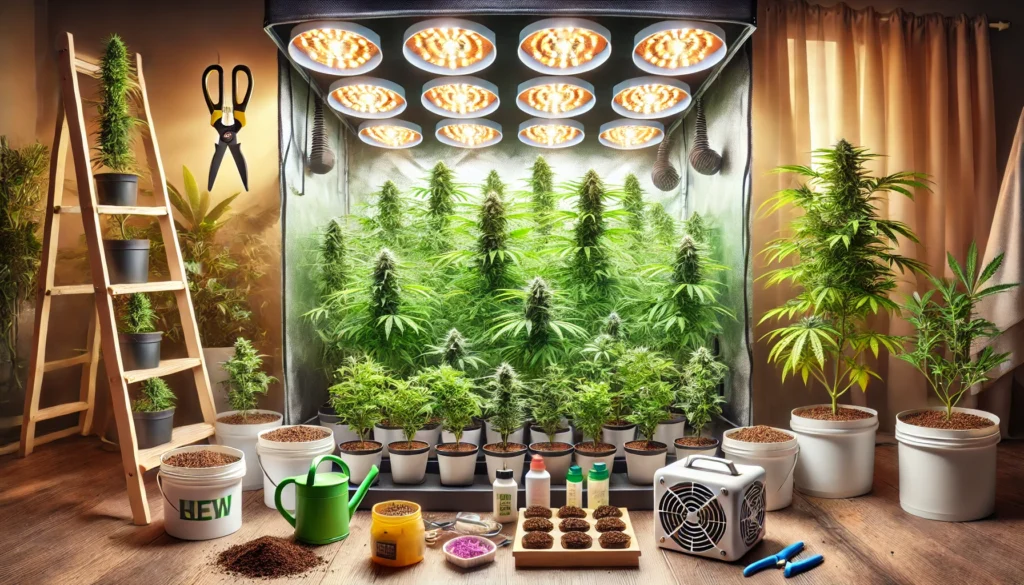Choosing the Right Cannabis Strain for Your Needs
When it comes to growing your own cannabis at home, choosing the right strain is like picking the perfect coffee blend. Some strains wake you up, others mellow you out, and the wrong one might leave you wondering what went wrong. Whether you’re growing for medicinal purposes or just curious about the process, selecting the right strain is the first step to success. Let’s break it down in a way that makes this decision simple and fun.
Indica, Sativa, or Hybrid: What’s the Difference?
First, you’ll need to decide whether you want an indica, sativa, or hybrid strain. Think of indica as the relaxing strain—it’s perfect for unwinding after a long day or managing pain and insomnia. If you’ve heard the term “couch lock,” that’s usually an indica doing its thing.
On the other hand, sativa strains are your go-to for daytime energy and creativity. These strains are uplifting and often help with focus and mood. They’re a favorite for battling fatigue or low motivation. Finally, hybrids give you the best of both worlds, combining traits from both indica and sativa. If you’re unsure, hybrids can be a safe bet to experiment with.
The trick is knowing what you need. Are you looking to ease chronic pain or sleep better? Indica might be your answer. Need a daytime boost or some help with social anxiety? Sativa could be your new best friend. When in doubt, hybrids are there to keep things balanced.
Consider the Cannabinoids
It’s not all about the indica-sativa divide. Cannabinoids like THC and CBD play a huge role in how a strain works for you. THC is the compound responsible for the “high” feeling, but it also helps with pain, nausea, and appetite. If you’re looking for strong medicinal effects without as much psychoactivity, focus on strains with balanced THC and CBD levels.
CBD is the non-intoxicating superstar known for its calming and anti-inflammatory properties. High-CBD strains are ideal for managing conditions like anxiety, epilepsy, or chronic inflammation. Strains with minimal THC and high CBD let you reap the medicinal benefits without feeling “stoned.”
When buying seeds, look at the cannabinoid content listed on the label. A little research goes a long way in ensuring you get what your body needs. Pro tip: Always start with lower THC levels if you’re new to cannabis—your future self will thank you.
Matching Strains to Specific Medical Conditions
Cannabis isn’t just a one-size-fits-all solution. Different strains are better suited to specific medical needs, and understanding this can make your growing experience far more rewarding. For example, strains like Granddaddy Purple and Northern Lights are renowned for their ability to manage pain and insomnia. They’re heavy indicas, so expect a restful vibe.
If anxiety relief is your goal, look for strains high in CBD, like ACDC or Cannatonic. These strains help soothe the mind without overwhelming psychoactive effects. For mood-boosting and fighting depression, sativa strains like Jack Herer or Green Crack are often recommended for their uplifting effects.
Got muscle spasms or severe chronic pain? Consider strains like Blue Dream or OG Kush, which combine pain relief with a manageable euphoria. Matching the strain to your medical needs isn’t just about effectiveness—it’s also about making sure your growing efforts serve a real purpose.
Think About Your Growing Conditions
Your growing environment will also influence the strains you can choose. Some strains thrive indoors, while others prefer the great outdoors. Indicas are typically more forgiving for indoor setups, as their shorter and bushier growth makes them ideal for limited spaces.
Sativas, on the other hand, can grow tall and require more room and patience. If you’re growing outdoors in a sunny climate, a sativa strain like Durban Poison could thrive. For cooler or wetter environments, hybrids like White Widow might be a better fit.
Before choosing a strain, take stock of your space, climate, and equipment. Growing is much more fun when your plants cooperate with your setup!
Choosing the right cannabis strain is an exciting part of the growing journey. Whether you’re aiming to improve sleep, manage pain, or simply explore the joys of cultivation, there’s a perfect strain out there for you. Do your research, consider your medical needs, and align your choice with your growing environment. Once you’ve found your match, you’ll be well on your way to cultivating your ideal medicinal cannabis experience. Happy growing! 🌱
Setting Up Your Perfect Home Grow Space
Starting your own cannabis grow at home is like setting up a mini garden with a bit more science and excitement. Your grow space is the foundation for healthy, happy plants, so it’s worth taking the time to get it right. Whether you’re working with a closet or a spacious backyard, let’s dive into how to create the perfect setup for your cannabis-growing adventure.
Indoor or Outdoor: Choosing the Right Space
The first big decision is whether to grow your cannabis indoors or outdoors. Indoor growing gives you control over light, temperature, and humidity, making it ideal if you live in an unpredictable climate or have nosy neighbors. Plus, with grow tents or dedicated spaces, you can grow year-round without worrying about the seasons.
Outdoor growing, on the other hand, lets you take advantage of free sunlight and fresh air—nature’s ultimate grow team! If you have a private backyard or balcony with plenty of direct sunlight, this could be a low-cost and rewarding option. Just keep an eye on the weather, pests, and any curious critters that might find your plants appealing.
Think about your lifestyle and resources. Are you ready to monitor and tweak a controlled indoor environment, or would you rather let Mother Nature handle the heavy lifting? Either way, the key is to choose a space where your plants can thrive and stay protected.

Essential Equipment for Your Grow Space
Setting up your grow space is a little like building a cool science lab, but way more fun. For indoor growers, start with a grow tent or designated room. Tents are great because they’re compact, reflective, and easy to set up. Next, invest in a good set of grow lights. LED lights are energy-efficient, long-lasting, and provide the right spectrum for your plants at every stage of growth.
You’ll also need a ventilation system to keep the air fresh and prevent mold or mildew. A combination of exhaust fans, carbon filters (to reduce odor), and oscillating fans will do the trick. Don’t forget to add a thermometer and hygrometer to monitor temperature and humidity levels—they’re small but mighty tools for successful growing.
Outdoor growers, your setup is simpler. Pick a spot with at least six hours of direct sunlight daily and ensure your plants have enough space to grow without being crowded. Consider using pots or raised beds to give you more control over soil quality and drainage. And don’t forget fencing or netting if local wildlife tends to snack on leafy greens.
Optimizing Light, Air, and Water
Light is the lifeblood of your cannabis plants, so getting it right is crucial. Indoors, your grow lights should mimic the sun’s natural cycle. Use a timer to give your plants 18 hours of light and 6 hours of darkness during the vegetative stage, then switch to 12 hours each during flowering. Keep lights at the right height—too close, and you’ll burn your plants; too far, and they’ll stretch and weaken.
Good airflow is another must. Think of it as your plants’ gym—it keeps them strong and helps prevent mold. Fans circulating air inside your grow space mimic a gentle breeze, which strengthens stems and keeps pests at bay.
Finally, water is life. Avoid overwatering, a common mistake for beginners. A good rule of thumb is to water when the top inch of soil feels dry. Use clean, pH-balanced water to keep nutrients accessible to your plants. Too acidic or alkaline, and your cannabis might struggle to absorb all the goodness you’re providing.
Keeping It Discreet and Legal
Before setting up your grow space, make sure you’re clear on local cannabis cultivation laws. Growing without the proper permits can land you in hot water, even if it’s just for personal use. Many regions have strict guidelines about plant counts, space, and security, so do your homework before you plant your first seed.
Discretion is key if you live in a shared space or have curious neighbors. Indoor growers can use carbon filters to minimize the telltale smell of cannabis, while outdoor growers might consider planting companion plants like lavender or basil to mask the aroma. A little extra planning goes a long way in keeping your grow stress-free and under the radar.
Setting up your perfect home grow space is part science, part art, and a whole lot of fun. Whether you’re going all-in on a high-tech indoor setup or letting the sun do its thing outdoors, the goal is the same: creating an environment where your cannabis plants can thrive. With the right equipment, attention to detail, and a sprinkle of patience, you’ll be on your way to growing your own medicinal cannabis in no time. Happy planting! 🌱
Caring for Your Cannabis Plants Like a Pro
Growing cannabis at home is more than just planting seeds and waiting for magic to happen. Your plants need consistent care, attention, and a little bit of love to thrive. If you’re ready to learn the basics of plant care, don’t worry—it’s easier than it sounds. Let’s dive into some practical tips to ensure your cannabis plants grow happy, healthy, and strong.
Watering Wisely: Finding the Goldilocks Zone
One of the easiest ways to mess up your cannabis plants is by overwatering or underwatering them. It’s like making coffee—too much water, and you dilute the magic; too little, and things get burnt out. The trick is finding that Goldilocks zone where everything feels just right.
Start by checking the top inch of soil with your fingers. If it feels dry, it’s time to water. If it’s still moist, let it be. When you water, aim for the base of the plant and avoid soaking the leaves, as this can invite mold. And don’t forget drainage! Pots with holes in the bottom are your plants’ best friends—they prevent roots from sitting in water, which can lead to root rot.
As a rule of thumb, cannabis plants drink more during the flowering stage, so keep an eye on their thirst levels as they grow. Over time, you’ll develop a sixth sense for when your plants need a drink.
Feeding Your Plants: The Right Nutrients at the Right Time
Cannabis plants are like gourmet diners—they thrive when given the right nutrients in the right amounts. During the vegetative stage, your plants will crave nitrogen, which helps them grow lush and green. Once they enter the flowering stage, they’ll want more phosphorus and potassium to support bud production.
Invest in a good-quality nutrient mix designed for cannabis. Follow the instructions carefully and avoid the temptation to overfeed. Yes, it’s possible to love your plants too much! Overfeeding can lead to nutrient burn, where the tips of your leaves turn crispy and brown. Not a good look.
If you’re into organics, consider using natural fertilizers like compost or worm castings. These provide a slow-release nutrient boost and are kinder to the environment. Whatever you choose, just remember: feed your plants, but don’t drown them in it.
The Importance of Pruning and Training
Did you know your cannabis plants love a good haircut? Pruning is essential for removing dead or unnecessary leaves, allowing light to reach the lower parts of the plant. This improves air circulation and helps your plants focus their energy on producing bigger, better buds.
Start by removing yellowing leaves or anything blocking light from reaching the plant’s center. Be gentle—your plants may be hardy, but they’re not indestructible. While pruning, you’ll also notice how your plant is growing. This is a good time to consider training techniques like topping, low-stress training (LST), or supercropping.
Training might sound fancy, but it’s just about helping your plant grow in a way that maximizes its potential. For example, topping involves cutting the main stem to encourage bushier growth. LST uses gentle bending to create a more even canopy, ensuring all parts of the plant get equal light. With a little practice, you’ll become a pruning and training pro.
Keeping an Eye on Pests and Problems
Cannabis plants are like magnets for bugs and diseases, so it’s your job to keep an eye out for anything suspicious. Common pests include spider mites, aphids, and fungus gnats—all tiny critters with big appetites for your hard work.
Inspect your plants regularly, especially under the leaves where pests like to hide. If you spot any unwelcome visitors, act quickly. Organic pest control options like neem oil or insecticidal soap are safe and effective. Avoid chemical pesticides—they can leave residue on your precious buds.
It’s not just pests you need to watch out for. Keep an eye out for signs of nutrient deficiencies, like yellowing leaves or slow growth. Addressing issues early is the key to saving your plants from unnecessary stress. Think of yourself as their personal doctor, always ready to diagnose and treat.
Giving Your Plants the Love They Deserve
Cannabis plants respond to care and attention, and the more you put in, the more you’ll get out. Spending time with your plants isn’t just good for them—it’s therapeutic for you too. Watch how they grow, admire their resilience, and celebrate the small victories, like the first sign of flowering.
With proper watering, feeding, pruning, and pest control, your cannabis plants will thrive. And when harvest time rolls around, you’ll feel a deep sense of pride knowing you cared for those plants like a pro. So grab your watering can, keep those scissors sharp, and show your plants some love—they deserve it, and so do you! 🌱
Harvesting, Drying, and Storing Your Medicinal Flower
Harvesting your cannabis plants is like picking the perfect apple—it’s all about timing and technique. But once the hard work of growing is done, the journey isn’t over. How you harvest, dry, and store your medicinal cannabis flower can make or break its quality. Don’t worry; we’ll walk through this process step-by-step so you can get the most out of your efforts.
Knowing When It’s Time to Harvest
Timing your harvest is key to getting the most potent, flavorful flower possible. The secret lies in the trichomes—those tiny, crystal-like structures on your buds. Using a magnifying glass or a jeweler’s loupe, look closely at them. If they’re clear, your flower isn’t ready yet. When they turn milky white, it’s a sign your plants are at peak potency. If they start turning amber, it’s still fine but will have a more sedative effect.
Don’t forget to check the pistils too—those little hairs sticking out of the buds. When 70-90% of them have turned from white to reddish-brown, your plant is likely ready. Harvesting isn’t a race; it’s a dance with nature. The more you pay attention to these details, the better your results will be.
The Art of Trimming and Drying
After harvesting, it’s time to trim your buds. There are two main methods: wet trimming and dry trimming. Wet trimming involves cutting away fan leaves and sugar leaves right after harvest, while dry trimming happens after the buds have been dried. Wet trimming is faster and helps with airflow during drying, but dry trimming can preserve more of the flower’s terpenes. Choose the method that works best for your setup.
Next up is drying—a crucial step for preserving potency and flavor. Hang your trimmed buds upside down in a dark, cool, and well-ventilated space. Aim for a temperature of around 60-70°F (15-21°C) with a humidity level of 50-60%. Drying usually takes about 7-10 days, but don’t rush it! Quick drying can lead to harsh, unpleasant-tasting flower.
How do you know when your buds are dry enough? Bend a stem. If it snaps cleanly instead of bending, your flower is ready for the next step.
Curing for Maximum Flavor and Potency
Curing is the secret sauce to taking your cannabis from good to great. Once your buds are dry, place them in airtight glass jars, leaving a little room at the top for airflow. Store the jars in a cool, dark place. Open them (a process called “burping”) daily for the first week to release built-up moisture and let fresh air in.
After the first week, you can burp the jars less often—maybe every few days. This process helps the buds break down chlorophyll, reducing harshness and enhancing their aroma and flavor. Curing can take anywhere from two weeks to a couple of months, but the longer you cure, the better the results. Patience pays off here!
Storing Your Flower the Right Way
Once your buds are perfectly cured, proper storage is essential to maintain their quality over time. Keep your flower in airtight containers, ideally made of glass. Plastic bags and containers can cause static, which pulls delicate trichomes off the buds. Nobody wants to waste those precious crystals!
Store your jars in a cool, dark place to protect your cannabis from light, heat, and humidity—all of which can degrade its potency. The ideal storage temperature is around 60-70°F (15-21°C) with a humidity level of 55-62%. Humidity packs can help keep the moisture levels just right if you live in a dry or humid area.
Pro tip: Avoid keeping your flower in the refrigerator or freezer. The cold can cause trichomes to become brittle and break off, diminishing the quality of your buds.
Enjoying the Fruits of Your Labor
By the time you’ve harvested, dried, cured, and stored your cannabis flower, you’ll have a product you can be proud of. The attention to detail during these steps pays off in the form of smoother, tastier, and more potent flower. Plus, there’s nothing quite as satisfying as knowing you grew, harvested, and stored it all yourself.
So, grab your scissors, prepare your jars, and let the process unfold. With a little patience and care, you’ll be enjoying your medicinal cannabis like a pro in no time. Happy harvesting! 🌿




